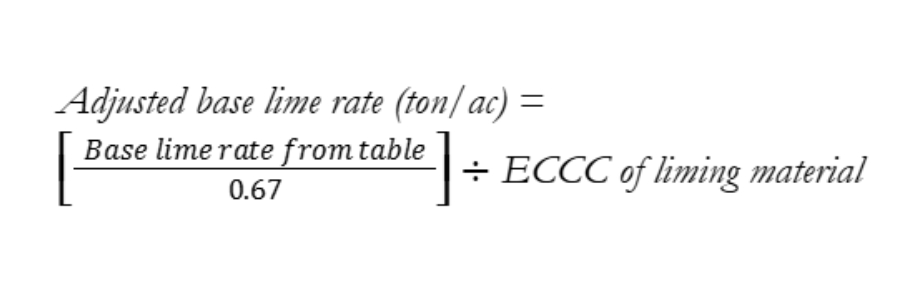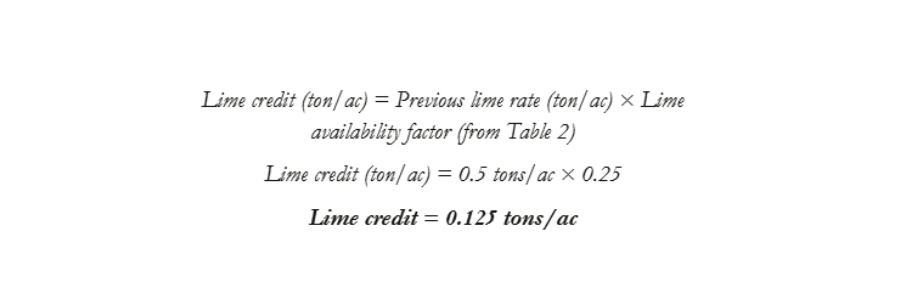
Fact Sheets And Publications

Calculating the Lime Recommendation Using the Adams-Evans Soil Buffer
May 2025 | Amy L. Shober, Karen L. Gartley, and J. Thomas Sims
Introduction
The University of Delaware (UD) Soil Testing Lab uses the Adams-Evans buffer pH method to determine lime requirement for a field based on soil test analysis of an 8-inch composite soil sample. This quick reference guide will walk you through the steps for determining the lime recommendation using the Adams-Evans buffer pH. Other regional soil testing laboratories may use a different soil buffer pH test to determine lime requirement (Table 1). If the lime requirement test was performed by laboratory using a different buffer pH method (e.g., Mehlich, Modified Mehlich, SMP, or Sikora), refer to Measurement and Management of Soil pH for Crop Production in Delaware (available at http://www.udel.edu/0013466); Shober et al., 2024) for the appropriate lime tables.
Table 1. Buffer pH test methods used by regional soil testing laboratories.
| Laboratory | Lime Requirement Method |
|---|---|
| University of Delaware | Adams-Evans |
| AgroLab | SMP |
| Brookside Laboratories, Inc. | SMP/Sikora |
| Penn State University | Modified Mehlich |
| Rutgers University | Adams-Evans |
| Spectrum Analytical Laboratories | Sikora |
| Virginia Tech | Modified Mehlich |
| Waters Agricultural Laboratories, Inc. | Adams-Evans (KY location); Mehlich (NC location) |
| Waypoint Analytical | Mehlich; SMP (by request only) |
Making a Lime Recommendation
Follow these steps to make a lime recommendation:
1. Determine the target pH of the crop and select the appropriate Adams-Evans lime table. Tables are available for 6- and 8-inch soil samples for all target pH levels except for target pH 4.8.
The University of Delaware groups crops into seven different soil target pH values. Crop specific listings of target pH and critical pH are available in Measurement and Management of Soil pH for Crop Production in Delaware (available at http://www.udel.edu/0013466); Shober et al., 2024). Note: If soil organic matter (OM) is greater than 6% (based on the soil test report), use a target pH of 5.6.
Target pH 4.8 – Blueberries (no lime table; soil will likely need acidification)
Target pH 5.2 – Non-scab resistant potatoes
Target pH 5.6 – Acid loving plants; black, high organic matter soils
Target pH 6.0 – Most Delaware crops
Target pH 6.2 – Some vegetable and forage crops
Target pH 6.5 – Many commercial vegetable crops; commercial turf; high Ca demand crops
Target pH 6.8 – Alfalfa and herbs
2. Obtain the water pH and buffer pH values from the soil test report. Determine the base lime rate from the appropriate Adams-Evans lime table by selecting the value where the water pH row (shown along the left side of table) and the buffer pH column (shown across the top of the table) intersect. Alternatively, the base lime rate can be calculated using the equations available in A Comparison of Methods to Determine Lime Requirement (available at http://www.udel.edu/0013612).
Note: the base lime rates are for agricultural grade lime, which is assumed to have 67% effective calcium carbonate content (ECCC). Refer to Liming Materials and Management (available at http://www.udel.edu/0013552) to calculate the ECCC of other liming materials. Base lime rates from the look up tables can then be adjusted for alternative liming materials using the following equation:

3. Determine whether a lime credit is necessary. The lime credit (reported in tons/ac) is used to account for any lime that was applied in the past 18 months that has not had a chance to react, as calculated using the equation:
Lime credit (ton/ac) = Previous lime rate (ton/ac) × Lime availability factor
Where the previous lime rate (tons/ac) is the amount of any liming material applied within 18 months of the soil sampling event and the lime availability factor is based on the length of time since last application (Table 2).
Table 2. Availability factor used to adjust lime rates when liming materials were applied within 18 months of the current soil test.
| Time Since Lime Application (months) | Lime Availability Factor |
|---|---|
| 0-6 | 0.75 |
| 7-12 | 0.50 |
| 13-18 | 0.25 |
| >18 | 0.00 |
4. Determine the net lime requirement by subtracting the lime credit from the base lime recommendation, as determined from the current soil test using the following equation:
Net lime requirement (tons/ac) = Base lime requirement (ton/ac) × Lime credit (ton/ac)
5. Determine the type of lime recommended (e.g., calcitic or dolomitic agricultural-grade lime) based on Mehlich-3 (M3) soil test calcium (Ca) and magnesium (Mg) values obtained from the soil test report as outlined in Table 3.
Table 3. Recommended type of lime as a function of Mehlich 3 soil test Ca and Mg concentrations as reported in University of Delaware fertility index value (UD-FIV).
| Soil Test Levels* | Lime Type |
|---|---|
| M3-Mg is less than 50 UD-FIV M3-Mg between 50 and 100 | Dolomitic |
| UD-FIV AND M3-Mg is less than M3-Ca | Dolomitic |
| M3-Mg greater than 100 UD-FIV M3-Mg is greater than 50 | Calcitic |
| UD-FIV AND M3-Mg is greater than M3-Ca | Calcitic |
*Soil test Mg value of 50 UD-FIV is equivalent to 131 lb/ac (65.5 ppm) and 100 UD-FIV is equivalent to 262 lb/ac (131 ppm). Soil test Ca of 50 UD-FIV is equivalent to 1000 lb/ac (500 ppm) and 100 UD-FIV is equivalent to 2000 lb/ac (1000 ppm).
Adjusting the Lime Recommendation based on Tillage System
The lime recommendation may need to be adjusted for fields managed under conservation tillage or no-till. The University of Delaware recommends submitting a 2-inch composite sample from fields managed under conservation tillage or no-till to the soil testing lab to determine the need for lime. If the soil pH of the 2-inch composite sample from the same field is below the critical pH, we recommend also that the soil test laboratory run the lime requirement test on a 6- or 8-inch composite sample. If lime is recommended for the 6- or 8-inch composite sample, determine the appropriate base liming rate for conventional tillage systems. If lime is not recommended for the 6- or 8-inch composite sample, surface apply 1.5 tons/ac of agricultural grade limestone to raise the soil pH in the surface soil layer.
Example Lime Recommendation
The following example illustrates how to make a lime recommendation for conventionally-tilled grain corn grown on a field that received 0.5 tons/ac of agricultural grade calcitic lime 15 months ago. The soil sample was collected in the fall prior to the crop to a depth of 8 inches (Table 4).
Table 4. Information Obtained from the Soil Test Report -- Example Lime Recommendation.
| Parameter | Value | Reason |
|---|---|---|
| Soil organic matter, % | 1.2 | To determine if the target pH for high organic matter soils should be used. |
| Water pH | 5.4 | Also called soil pH. Used to determine base lime rate from table. |
| Buffer pH | 7.65 | Used to determine base lime rate from table. |
| Mehlich-3 soil test Mg, UD-FIV | 78 | Used to select the type of lime. |
| Mehlich-3 soil test Ca, UD-FIV | 184 | Used to select the type of lime. |
The target pH for grain corn is 6.0 based on the University of Delaware Nutrient Recommendations (available at http://www.udel.edu/008353) for agronomic crops.
Determine the base lime rate using the Adams-Evans Lime Recommendation Table for target pH 6.0 (excerpt shown here; Table 5). The base lime rate is reported in tons/ac based on neutralization of pH to a depth of 8 inches using agricultural grade limestone with 67% effective calcium carbonate content (ECCC).
Table 5. Excerpt from the Adams-Evans Lime Recommendation for target pH 6.0 -- Example Lime Recommendation.
| Water pH | Adams-Evans Buffer pH | |||||
|---|---|---|---|---|---|---|
| 7.80 | 7.75 | 7.70 | 7.65 | 7.60 | 7.55 | |
| 5.6 | 0.50 | 0.50 | 0.50 | 0.50 | 0.75 | 0.75 |
| 5.5 | 0.50 | 0.50 | 0.50 | 0.75 | 0.75 | 0.75 |
| 5.4 | 0.50 | 0.50 | 0.75 | 0.75 | 1.00 | 1.00 |
| 5.3 | 0.50 | 0.75 | 0.75 | 1.00 | 1.25 | 1.25 |
| 5.2 | 0.50 | 0.75 | 0.75 | 1.00 | 1.25 | 1.25 |
The base lime rate for this corn crop is 0.75 tons/ac.
The lime credit is calculated using the information provided by the grower (0.5 tons/ac calcitic lime applied 15 months ago using the equation:

The net lime requirement is determined by subtracting the lime credit from the base lime recommendation:

We recommend using dolomitic lime because the Mehlich 3 soil test Mg value (78 UD-FIV) is between 50 and 100 UD-FIV AND is less than the Mehlich 3 soil test Ca value (184 UD-FIV).
Final lime recommendation = 0.625 tons/ac of
dolomitic lime
References
Shober, A. L., Gartley, K. L., Miller, J. O., & Taylor, R. W. (2024). Nutrient management recommendations. University of Delaware. http://www.udel.edu/008353
Shober, A. L., Gartley, K. L., & Sims, J. T. (2025). A comparison of methods to determine lime requirement. University of Delaware. http://www.udel.edu/0013612
Shober, A. L., Gartley, K. L., & Sims, J. T. (2025). Liming materials and management. University of Delaware. http://www.udel.edu/0013552
Shober, A. L., Gartley, K. L., & Sims, J. T. (2024). Measurement and management of soil pH for crop production in Delaware. University of Delaware. http://www.udel.edu/0013466
Wyenandt, C. A., & van Vuuren, M. M. I. (Eds.). (2024). 2019 Mid-Atlantic commercial vegetable production recommendations. Rutgers University. http://www.udel.edu/0012565
About the Authors
Amy L. Shober (corresponding author), Professor and Extension Specialist, University of Delaware, Newark, DE (ashober@udel.edu)
Karen Gartley, Director, University of Delaware Soil Testing Program, Newark, DE
J. Thomas Sims, Professor (retired), Environmental Soil Management, University of Delaware, Newark, DE
About this Publication
Original publication date: 1996
Revision date(s): 2019, 2025
Based on an original publication by J.T. Sims & K. Gartley (1996)
Peer Reviewers
Nicholas Adams, Extension Agent, University of Delaware Extension, Newark, DE
Lyndsie Mikkelsen, Extension Agent, University of Delaware Extension, Georgetown, DE
UD Cooperative Extension
This institution is an equal opportunity provider.
In accordance with Federal law and U.S. Department of Agriculture policy, Cooperative Extension is prohibited from discriminating on the basis of race, color, national origin, sex, age, or disability.
